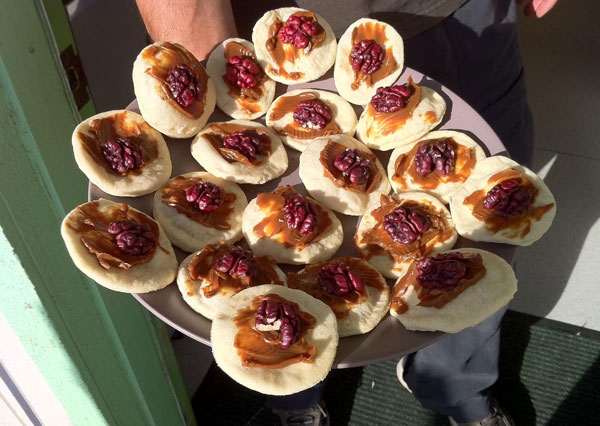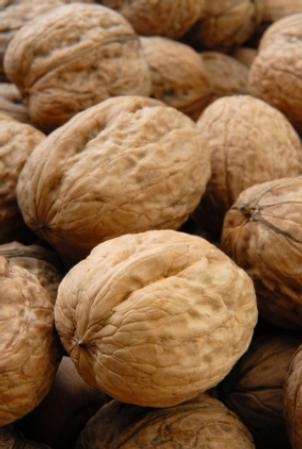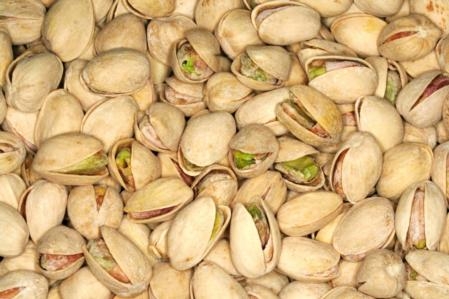Posts Tagged: Walnuts
Walnuts are trending upward
Proven health benefits is increasing demand for walnuts, and farmers are reacting by planting more trees, according to an article in the Chico Enterprise-Record. The trend has created a backlog for new trees.
"All the nut crops are doing very well," said Joe Connell, UC Cooperative Extension advisor in Butte County. Markets for almonds, pistachios and walnuts have expanded, and prices are firm, he said.
In 2011, walnuts became the No. 1 crop in Butte County. If growers want to plant new walnut orchards, they must get on a waiting list to buy them in 2015.
UC's red walnut featured in Fresno Bee
The lead food story in the Fresno Bee this week focused on walnuts and their local availability. An important component of the story was the red walnut, a cultivar developed by University of California breeders a decade ago.
Most walnuts grown in California have a light tan seed coat. The "Robert Livermore" walnut has a red seed coat.
"It has a very interesting color and gives consumers and farmers another option," said Chuck Leslie, staff research associate in the Department of Plant Sciences at UC Davis.
Leslie says the nut does not taste significantly different than ordinary walnuts to him. Fresno Bee reporter Robert Rodriguez quoted a Sacramento food blogger in the story who said the red walnut has a milder flavor and works well in recipes ranging from salads to cookies.
UC's red walnut was named after the late Lake County walnut grower Robert Livermore, said Rachel Elkins, UC Cooperative Extension advisor for Lake and Mendocino counties. The Livermore family owns a historic ranch on Mt. St. Helena that is still in operation.
"Robert Livermore contributed to the breeding program and hence the walnut was named for him," Elkins said. "He managed the Bishop Ranch in San Ramon which is now a large commercial business park, but was a very large fruit and nut ranch."

Red walnuts brighten up a plate of cookies.
California nut harvest winding down
- Almond growers expect to meet an early estimate of 1.95 billion pounds statewide, which would be a record
- Pistachio growers in the San Joaquin Valley are enjoying their second-largest crop ever after last year's record yield
- Walnut growers expect this year's yield to be 485,000 tons, slightly lower than last year's 503,000 tons
"The rumors I've heard is that guys are still complaining about the quality" of walnuts, said Rick Buchner, a University of California Cooperative Extension farm advisor in Red Bluff. "We're getting a lot of black husks on them, so there's a suggestion that we may have some husk breakdown and husk fly problems. It's probably too soon to tell yet."
San Francisco meeting generates research buzz
A meeting this week of the American Chemical Society turned two interesting UC research projects into headline news.
UC Davis nutrition professor Paul Davis reported that walnuts slowed prostate tumors by 30 percent to 40 percent in mice, according to a UPI article. The dose was equivalent to 2.5 ounces for a typical man. Not only was prostate cancer growth reduced, but the mice had lower blood levels of a protein that is strongly associated with prostate cancer.Completely unrelated research presented at the meeting, also from UC Davis, questioned an often-quoted UN statistic that said animal agriculture produces 18 percent of greenhouse gas emissions, more than all transportation combined.
Air quality specialist Frank Mitloehner says the U.N. reached its conclusions for the livestock sector by adding up emissions from farm to table, including the gases produced by growing animal feed, animals' digestive emissions, and processing meat and milk into foods. However, for transportation it only considered emissions from fossil fuels burned while driving, according to a CNN story.
"This lopsided 'analysis' is a classical apples-and-oranges analogy that truly confused the issue," Mitloehner was quoted in the original UC Davis news release announcing his results.
At least one blogger wasn't fully convinced that the world can go back to eating meat guilt free. The writer of Guardian UK Environment Blog, Leo Hickman, wondered why more media outlets hadn't reported that Mitloehner receives a significant amount of research funding from the meat industry."I'm not saying that Mitloehner is a bought-off scientist in the pocket of Big Beef. . .," Hickman wrote. "My beef is that this funding information has not been deemed worthy of inclusion in the reports and blogs that have been so quick to leap on Mitloehner's findings as, in their eyes, further proof that environmentalists are just a bunch of unscientific cranks."
The American Chemical Society's national conference concludes today.

Frank Mitloehner
Food safety in walnuts an ongoing concern
The issue of food safety in walnuts was raised with more than 200 growers at the UC Cooperative Extension Sutter/Yuba/Colusa Walnut Day this week, according to an article in the Appeal-Democrat of Yuba County.
"We want our crop to be perceived as healthy to consumers and we want to grow a safe crop, too," the story quoted conference speaker Jennifer Getz, the California Walnut Board domestic marketing director.Consumers, farmers and regulators are concerned about E. coli and salmonella contamination in walnuts. The question, the article said, revolves around where pathogen problems begin and whether walnuts are susceptible. The U.S. Food and Drug Administration is stepping up inspections, and research and safety efforts are ongoing.
Increasing regulations in general is a significant challenge facing growers, Walnut Day participant Steven DeValentine told reporter Ashley Gebb. Regulations for environmental protection, worker safety and food safety raise expenses for farmers, he said, while food prices have been mostly stable the last 20 to 30 years.
According to the article, DeValentine said that he likes to attend the annual Walnut Day to stay on top of what is happening in his industry and he hopes budget cuts do not further impact research by the University of California.
"Without that we would not be able to maintain this competitive edge globally," DeValentine said.

A farmer admirers a walnut tree.



